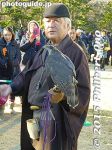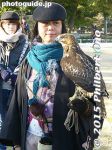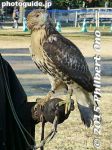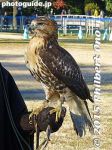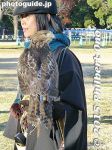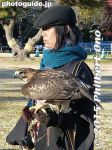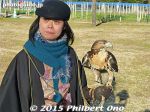 Image search results - "hama-rikyu" Image search results - "hama-rikyu" |

Hama-rikyu Onshi Teien Gardens is a waterfront garden built by the Tokugawa shoguns in the 17th century. During the Meiji Period, it became a Detached Palace for the Imperial family who gave the garden to the Tokyo in 1945. It used to have duck-hunting grounds. It was also the site of the Enryokan State Guesthouse where foreign dignitaries stayed such as former US president Ulysses Grant and Hawaii's King David Kalakaua.
|
|

Moat with Tsukijigawa River
|
|

Moat
|
|

Entrance to Hama-rikyu Onshi Gardens
|
|

Entrance to Hama-rikyu Onshi Gardens
|
|

Marker indicating the garden as a sightseeing spot and Special Historic Site.
|
|

Huge 300-year-old pine tree
|
|

300-year-old pine tree
|
|

300-year-old pine tree
|
|

Side view of 300-year-old pine tree
|
|
|

Site of the Enryokan State Guesthouse. Built in May 1869, it was Japan's first Western-style building made of stone. It served as an office of the Japanese navy before it was refitted as guest house. 延遼館
|
|

Site of the Enryokan State Guesthouse. Former U.S. President Ulysses Grant and his wife stayed there for two months in 1879 during their world tour. Hawaii's King Kalakaua also stayed here in 1881. He traveled by horse carriage to meet Emperor Meiji.
|
|

The U-shaped Enryokan was used as a guest house until 1883 when the new Rokumeikan 鹿鳴館 guest house was completed. Due to old age, the Enryokan was torn down in 1889. Many new Shiodome skyscrapers loom over the site.
|
|

Site of the Enryokan State Guesthouse. Under former Tokyo Governor Masuzoe, Tokyo had plans to faithfully reconstruct the Enryokan in time for the 2020 Tokyo Olympics. Plan has been shelved.
|
|

Old photo of Enryokan State Guesthouse.
|
|

Walking through the Enryokan site, now dotted with pine trees.
|
|
|

Many pine trees in the garden
|
|
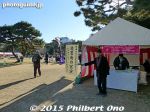
Hama-rikyu holds New Year's events on Jan. 3.
|
|
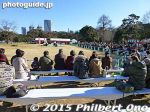
Spectator seats were set up.
|
|
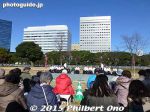
First they held aikido demonstrations.
|
|
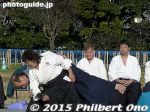
Aikido demonstrations at Hama-rikyu on Jan. 3, 2015.
|
|

After the aikido, falconry demonstrations were held at Hama-Rikyu Gardens on Jan. 3 as a New Year's event. (放鷹術実演) Hama-Rikyu Garden used to be where the Tokugawa shoguns and the Imperial family practiced falconry.
|
|

There were several falconers each with his or her own hawk. They are members of a falconry preservation group. They've been holding this event for 23 years here.
|
|
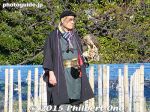
They don't use the same type of falconry birds that were used by Tokugawa shoguns. They now use Harris' hawks or red-tailed hawks imported to Japan. They are highly intelligent birds and can recognize human faces.
|
|
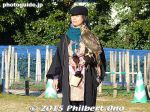
Notice that falconer wears a small pouch on his waist. It contains bird food. The bird is rewarded each time it does a trick.
|
|
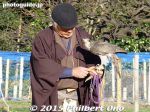
Magnificent birds. The local crows were quite alarmed by the presence of these hawks.
|
|

Falconry demo was held twice in the day. The first demo had the hawks released from the top of a nearby skyscraper and they flew down to their falconers in the garden.For the demo, they showed the hawks swoop low from one falconer to another. They also showed a live capture (kill?) of a released pigeon. Very fast.
|
|

They allowed a few people from the audience to try falconry. This is an Italian who was lucky enough to be chosen to hold and release this hawk.
|
|
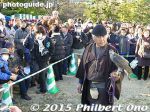
After the demo, they showed off the hawks for photos.
|
|
|
|
|
|
|
|
|
|
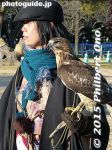
Falconry demonstrations held at Hama-Rikyu Gardens on Jan. 3 in Tokyo.
|
|
|

Falconry demonstrations held at Hama-Rikyu Gardens on Jan. 3 in Tokyo.
|
|
|
|

Gingko tree and pine tree in autumn
|
|

Gingko tree in autumn
|
|

Gingko tree and pine tree in autumn
|
|

English explanation for yuki-zuri which are those strings propping up the pine tree branches as a countermeasure against snow.
|
|
|

A small garden and little stream which was behind the Enryokan State Guesthouse.
|
|
|

Another entrance
|
|

This was the entrance and bridge which the Emperor passed through when visiting the garden.
|
|
|

Another entrance
|
|
|
|
|
|

Shiori-no-Ike Pond
|
|
|
|

Shiori-no-Ike Pond with ducks. This is a tidal pond.
|
|

Otsutaibashi Bridge over the pond.
|
|

Pine trees along the shore
|
|
|
|

Otsutaibashi Bridge
|
|
|
|
|
|
|
|
|
|
|
|

Straw band wrapped around the pine tree trunk to catch bugs crawling on the trunk.
|
|
|

Nakajima-no-Ochaya Tea House on the small island in the pond.
|
|

Nakajima-no-Ochaya Tea House
|
|
|

Nakajima-no-Ochaya Tea House
|
|
|
|

The garden would look better without all these skyscrapers in the background.
|
|

Shiodome skyscrapers overwhelm the little tea house
|
|

Tea house, pond, and pine tree
|
|
|
|
|

Duck-hunting wall
|
|

Tiny slits to look at the ducks
|
|

Duck hunting gutter
|
|
|

Former boat landing for the shogun
|
|

Sightseeing boat pier
|
|

Camellias
|
|

Camellias
|
|

Plum blossoms
|
|

Plum blossoms
|
|
|
|






























